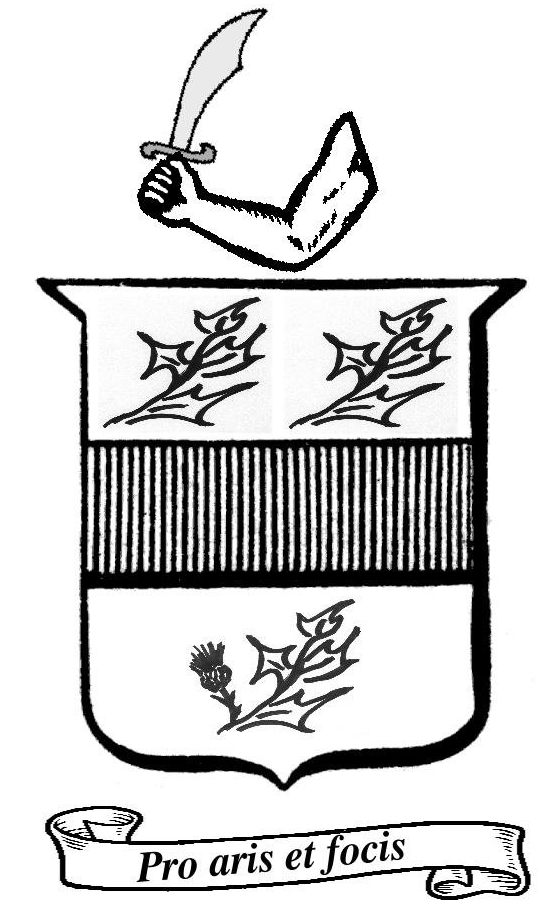Origins
of the Oregon Shortridge Family
Randall
Shortridge
Albion,
NY
November,
2008
Preface
In
adolescence, my brother, sister, and I frequently spent summer months
in Brownsville, Oregon, with our (Shortridge) grandparents where we
would sometimes ask about our family tree. It seems that I must
have shown most interest, so it was I who later came to be the de
facto custodian of
the information. It might have helped that I joined the Mormon
church, known for their dedication to genealogical work, while I was
still in high school. Later, after I had a falling out with Mormon
religion, and due to pressures of family and career, the family
history I collected seemed to get little attention. I attempted to
write a family history in 1988, started again in 1998, and now I am
at it again in 2008. So it seems that there is a ten-year pattern
emerging. I am determined to get something completed this time,
just in case I am lucky enough to be gone by 2018. This is despite
the fact that family history is something that really can't reach
completion. At the very least, I hope to have something that is in
a state of preservation to share with others before my files get lost
with most of the rest of our history.
In
the present document, I attempt to trace our Shortridge ancestors who
originated in the Lowlands of Scotland, from London England to
Fairfax, Virginia, to Bourbon County, Kentucky, to Wayne County,
Indiana, to Tippecanoe County, Indiana, to Muscatine County, Iowa,
and finally to Lane County, Oregon. I will focus primarily on the
Shortridge family, but will include some information on those bearing
ancestral (maternal) surnames hidden by marriage.
In
compiling the information on our ancestors, I was amazed at how many
were pioneers who came to America prior to the American Revolution,
some of them as much as a century before the United States became a
subject of conversation between the founding fathers. You might say
that we've earned the right to be here in America by being here a
long time. Yet, in one of the comedies of life, I was recently
obligated (re.
arm-twisted under a threat of no paycheck) to fill out a government
I9 form (for US Immigration status) which is now required to provide
legal proof that one is eligible to work in America. The comedy was
compounded by the fact that the form proving I was eligible to work
under 'immigrant status' was signed and certified by a fellow who was
born in India and recently become a naturalized US citizen. It
seems that somewhere along the line, we who still call ourself
Americans have lost our way. I think I can better understand the
mind of Daniel Boone and the settlers of Boon's Station after a
gaggle of lawyers arrived upon the scene with legal documentation
showing that they were the real owners of the property that those in
residence erroneously thought was theirs.
That
said, it seems that what really matters is who we are rather than
from whence we came. Yet we can still honor those who came before
us for their efforts, sacrifices, and living in a time when perhaps
there were more Americans on this land than there are today.
History seems to emerge as a redundant repetition that we should not
be so careless to overlook.
If
anyone among our ancestors should be given an award for serial
traveling, it would have to be Samuel Boone Shortridge who was born
in Kentucky in 1796, moved with his parents to Wayne County, Indiana,
about 1811, moved again to Tippecanoe County, Indiana about 1823
where his parents are buried and at least one brother and one sister
settled permanently, then moved again to Muscatine County, Iowa,
about 1835 where he lived for about 17 years before making the
difficult migration on the Oregon Trail to London, Oregon, in 1852,
then in 1858 making an eastward trip to Ogden, Utah, where, after a
short time in residence, he had to flee for his own safety back to
Oregon by hiding in a wheat wagon destined for San Francisco followed
by begging a stagecoach ride back to Oregon. This would have to
ballpark out at about 4,500 miles of traveling
across country in a time when it was done by foot, on horseback, or
by animal-drawn wagon.
Our
Oregon ancestor who should receive an award for hardships endured is
Lucinda Herrick, who unquestionably “saw the elephant” on the
journey west, to borrow from the parlance of the time. Lucinda
Herrick was the mother of Ellen Keyes, the wife of William Wallace
Shortridge and was known as 'Grandma Lane' by her Oregon descendants.
Lucinda and her family, who were devout Mormons at the time, were
part of a forced exodus from Illinois to Nebraska, then to Utah prior
to 1850. Journal histories say that her husband (Perry Keyes) died
in the wagon, resulting in a short pause of the wagon train at noon
of that day to bury him. He was buried between two slabs of bark.
This unfortunate death was in addition to the prior deaths of two of
Lucinda's young children while the family waited near Omaha, a sister
who died a few days before her husband perished, and a young son a
few weeks after. After enduring the hardships of the journey to
Utah, Lucinda went on to Lane County, Oregon, possibly arriving as
early as 1854. All of this before she was 35 years old. She
married twice more and died in Oregon in 1899.
A
hardship story that might rival that of Lucinda Herrick is about
Johannes Jaeger, a Switzerland-born ancestor of ours who was later
known under the anglicized form of his name, John Hunter. John came
to America from Rotterdam, Holland, when he was three years old in
company of his grandparents, parents, and older brother. His mother,
a young lady of about twenty five, died on the ship and was buried at
sea. His brother died about the same time, and within a few years of
arriving in America, young John Hunter's father died, leaving young
John to the graces of Orphan's Court. Like Lucinda Herrick, John
Hunter went on to live a full life, dying in Tennessee. John fought
in the American Revolution under the command of Abraham Lincoln,
grandfather of the famous American president.
Much
of the present document is a compilation of material contributed by
others. One who deserves recognition for his help is a cousin, Ken
Shortridge Jr., who has been a collaborator on Shortridge history for
over two decades. In 1988, it was Ken who phoned me with critical
information that led to the discovery of Samuel Shortridge's grave in
a forgotten part of Tippecanoe County, Indiana. Others who have been
helpful include Pat Ogden, Alvira Ward, Louise Licklider, Wilma Olds,
Maybelle Newton, June George, Barney Shortridge, Muncie
Shortridge, John Williams, Daniel Paxton, and Kathleen
Lipscomb. Undoubtedly, there were others that I've forgotten to
mention.
In
terms of legal matters, copyrights to this document are hereby placed
in the public domain. Making copies of this document and
distributing it to others is encouraged. Conveyance of copyrights
to the public domain does not transfer rights of individual items in
this document that might belong to others.
For
the time being, I welcome input from everyone for additions and
corrections that might be included in a newer edition. History, it
seems, is destined to be rewritten. And when it is all done, I
suppose, the history that's been rewritten will need to be rewritten
again. Maybe that's because history has as much to do with our
perspective as anything else.
Randall
D. Shortridge
contact
information: 4587 Townline Road
Albion,
NY 14411
585-798-1081
rds @ buffalo.edu
Contents
Preface
I.
Origins of Shortridge
II.
Earliest Known Shortridge Ancestors
III.
Our Shortridge Ancestors in America
IV.
Other Shortridge's in America
V.
The Migration to Kentucky
VI.
From Kentucky to Indiana
VII.
Indiana to Iowa
VIII.
The Journey to Oregon
IX.
Other Overland Journeys
X.
Biographical Sketches and News Reports
XI.
Descendants of Caroline, James, and WW Shortridge
XII.
Notes on the Oregon Shortridge Family
XIII.
Notes on Other Ancestors
XIV.
Photographs
XV.
Ahnentafel Chart from Lloyd Wayne Shortridge
XVI.
Pedigree Charts from Lloyd Wayne Shortridge
Chapter
References and Notes
List
of Appendices and Notes
Appendix
1: Descendants of William Shortridge
Appendix
2: Descendants of Richard Shortridge
Appendix
3: Descendants of Andrew Shortridge
Appendix
4: Descendants of Samuel Shortridge
Appendix
5: Shortridge History by Franklin Boone Shortridge
Appendix
6: Muster Roll of George Rogers Clark expedition
Appendix
7: Data for the Drury and Bookwalter Families
I.
Origins of Shortridge
The
surname Shortridge is Lowland Scottish from the southern part
of the country near the border with England
(1). The name (and
variations Shortrig, Shortrigg, Shortreid, Shortreed or possibly
Shoubridge and others) potentially originates at a parish location,
Shortrig, near Ecclefechan, Dumfriesshire, but it isn't clear if the
family name is lent to the Dumfries location or is derived from it.
Some have suggested that the name and variant spellings may be
derived from Olde English 'Sceort hryeg'
of the seventh century AD (2).
Locational names were sometimes taken for legal purposes, such as
when having a distinguishing name was required after Poll taxes (a
tax placed on an individual or “head”) were instituted.
Originally, Shortrig may have meant to designate a specific
individual who was 'A dweller from Shortrig'.
One
of the earliest occurrences of the Shortridge name is to be found in
"Testamenta Karleolensis" which states that the will
of Richard de Shortrigges of Thoewsby was proved at Rose on the 5th
August, 1362. That of his wife was proved the same day,
administration being granted in both cases to Robert de Croftonm
executor under the will, his co-executor, John de Shortrigges being
dead (3). The valley of Rulewater on the northern slopes of the
Cheviot hills was the home of the Shortriggs in the seventeenth
century, where they intermarried with the great border families,
including the Elliotts and Scotts. Sir Walter Scott himself was on
terms of intimate friendship with Robert Shortreid (4), whose name
occurs in Lockhart's biography of the famous poet.
A
few other instances of Shortridge
come from the 1500's and 1600's in the same region near the Scottish
border with England. A John Schortrek signed the Band of Dumfries,
1570, and a John Schortrig was burgess of Dumfries, 1592. On
December 21, 1619, landed property under the Knights Templar is
recorded as being transferred from William Maxwell of Carnsalloch to
Adam Shortridg, son of John Shortridg,
at 'Bridge end' (location of transaction) (5).
There appears a John Shortrig of Garneselloche, 1626
(Dumfries). Robert Shortrigg at Bridgend signed the Test in 1684
and Elizabeth Shortrigg is recorded in Dumfries in 1689. Shortrick
appears in 1657. Shortreed is a surname that is said to occur only
on the Border generally in the neighborhood of Kelso. Several of the
name served in India in a civil or military capacity. Euphan
Shortreid is recorded in Selkirk, 1684.
These
southernmost counties of Scotland nearest the border with England,
which includes the region of Dumfriesshire, are also known as the
Borders. They are sometimes considered separately to the rest of the
Scottish Lowlands, though they might also encompass a region of
rolling hills called the Cheviots where the Shortridge's are known to
have resided. This Lowland region of Scotland also includes
Renfrewshire, the ancestral homeland of the famous Scottish hero,
William Wallace, the same who is said to be the inspiration for the
legend of Robin Hood (6). Lowland Scottish families were among those
that relocated to the Ulster Plantation (land confiscated from Irish
Catholics by the British Crown after the Nine Years War in the late
1500's) and whose (Scottish) descendants later migrated to the
America's and became known as Ulster-Scots or Scots-Irish. These
Scots-Irish, as well as the Border families remaining in the Scottish
Lowlands (from whence probably came our Shortridge ancestors), were
known for their fierce independence and dislike of outside hierarchal
authority. Their migrating descendants (Scot's and Scots-Irish) are
generally known to have settled predominantly in the southern
colonies of Virginia (later Virgina, Kentucky, and West Virginia),
North Carolina, South Carolina, and Georgia.
Image
of Scottish hero William Wallace, after who William
Wallace Shortridge appears to have been named (7).
William Wallace Shortridge is our ancestor who journeyed across
the Oregon Trail in 1852 at the age of sixteen with his father,
Samuel Boone Shortridge. Samuel Boone Shortridge settled near
Cottage Grove, Oregon, where Shortridge Park today stands on part
of his original land claim of 160 acres. Samuel Boone Shortridge
and his son, William Wallace Shortridge, are buried nearby.
|
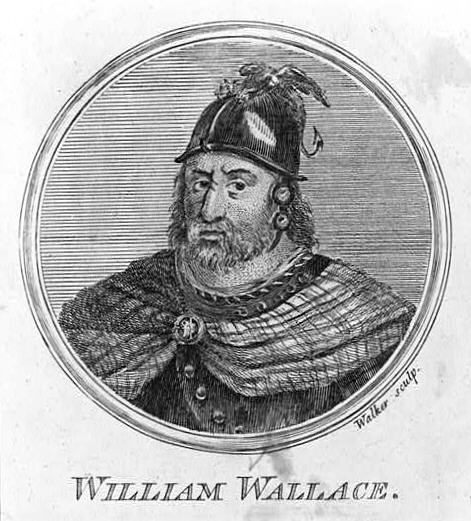
|
There
is apparently is a street of dwelling houses called Shortridge
Terrace in Newcastle-upon-Tyne (Northumberland), England, and a
Shortridge Hall in Northumberland near the coast,
that has been converted into a nursing home
(8).
|
Based
on descriptions, this is how the Shortridge arms might have
looked. In color, the shield would have been silver, the
horizontal band would have been red, and the thistles green.
|
The
arms of Shortridge are: ARGENT (Old English meaning silver shield
background), a fesse gules (horizontal bar of red) between three
thistles vert (green) flowered on the second. CREST: A dexter
(right) hand holding a scimitar proper. MOTTO: "Pro
aris et focis"
(For our homes and altars)
(1,3).
|
II.
Earliest Known Shortridge Ancestors
(William
> John > John Shortridge II)
Our
earliest Shortridge ancestor for whom I have a record is William
Shortridge
(born c1630)
who resided in England, probably in London, and
married
Philadephia Luke
(born c1630)(1).
William Shortridge and Philadelphia had three known children (2):
(i)
John Shortridge (our
ancestor), born bef 1670, married
Elizabeth Potter abt
1683 at St. Boltolph without Aldgate Church, London, England.
(ii)
Mary Shortridge, b. abt 1674 in England.
(iii)
Elizabeth Shortridge, b. abt 1679 in England.
John
Shortridge
(son of William Shortridge and Philadelphia Luke) married
Elizabeth Potter
(our ancestors) and had at least six children (2):
(i)
Elizabeth Shortridge, born 1684, married Thomas Clarke.
(ii)
Mary Shortridge, born1686.
(iii).
John Shortridge II
(our
ancestor), born December 25, 1688 at St. Boltolph without Aldgate
Church, London, England, and
married Mary Gilbert,
daughter of Michael Glibert and Jane. John Shortridge II and Mary
Gilbert immigrated to the American colonies (Virginia) sometime
before 1704. Mary Gilbert's father, Michael Gilbert also migrated to
VA before 1704 (per the court records of Westmoreland County – see
next chapter). Mary Gilbert's brothers, William, John, and Michael,
probably arrived America at probably the same time (see Chap III).
(iv)
Sarah Shortridge, b. abt 1690.
(v)
William Shortridge, b. abt 1690.
(vi)
Peter Shortridge, b. abt 1693.
According
to the Shortridge family history written by Franklin Boone Shortridge
(3), an early English ancestor of ours was an Earl of
Leicester of Brace Brig Hall on the border between England and
Scotland. I was unable to find any corroborating information to this
claim. The Earls of Leicester (a title of peerage) during the time
in question were Robert Dudley (1564, first Earl) and several members
of the Sidney family (1618-1744, second to seventh Earl). I also
have yet to find any reference to a Brace Brig Hall or a site under a
similar name (eg.
Brace Bridge) in Northumberland.
III.
Our Shortridge Ancestors in America
(John
II > William > George David Shortridge)
The
founder of our house in America was John
Shortridge II,
a son of John Shortridge
and Elizabeth Potter of London, England. John
Shortridge II and his wife,
Mary Gilbert immigrated to
the American colonies before 1704 where there emerges evidence of
their being in America from a lawsuit brought against John Shortridge
II (indentured servant) by Michael Gilbert (plaintiff), his
father-in-law. It's clear from this suit that John Shortridge
arrived in America as an indentured-servant to his in-law relative,
Michael Gilbert. Indentured servitude was a common mechanism by
which the costs of migrating to the colonies were paid to a
benefactor though a fixed time-period of servitude or indenture.
In
the above-mentioned lawsuit of 1704, Michael Gilbert sues John
Shortridge, claiming that John, his servant (according to the
complaint), “had
greatly abused him, tore him by his hair, and thrown him to the
ground.”
Apparently, there was some sort of falling out between John
Shortridge and his father-in-law to whom he was indentured. The
Virginia court found in favor of Michael Gilbert, the plaintiff in
the suit, by penalizing John Shortridge with one additional year of
indentured servitude after the regular indenture expired (1).
Later,
Michael Gilbert (our
ancestor), was feeling sick
(“weak of body”
-- his words) which caused him to write his Will (in October of 1717)
which came to probate upon his death in November of that same year.
In this Will, Michael named three sons (William, John, and Michael)
as immediate inheritors of his estate and property, showing that
several brothers of Mary Gilbert also immigrated from England to
America (2).
By
that time, John Shortridge II and Mary Gilbert had at least one
child, William Shortridge
(our
ancestor), born in
Fairfax County, VA, about 1707. This William Shortridge was the
first of our surname ancestral line to be born on American soil.
Despite the apparent falling-out between John Shortridge
and his father-in-law, Michael Gilbert, the latter exhibited concern
and interest in the welfare of his grandchild, William (Shortridge),
then about 10 years old (1717), with a notation in his will giving
property unto William specifying that “he
have schooling allowed him out of his part of estate” (2).
William
Shortridge
(our
ancestor)
later
married Mary
Stubblefield-Emms in Fairfax, Co, about 1739 and died 16 June 1783 at
Scott Run, Fairfax, Co, VA
(3).
Given the birthdate of William's youngest son, George David
Shortridge (1728), this might be the second marriage for William.
Mary
Stubblefield-Emms was the daughter of Thomas Stubblefield and Ellen
Hackley. It is unclear why the name Emms appears after the
Stubblefield surname. However, an indenture is recorded on “19
April 1744 between Edward Emms of county of Fairfax planter &
William Shortridge of same county . . for five pounds sterling . .
sells 46 acres . . signed by Edward Emms in presence of John
Hamilton, John Harris, Walter English. Release recorded 19 April
1744”
(4). Thus, there appears that there is an association between the
Shortridge's and a family named Emms. It may be that the marriage
of Mary Stubblefield to William was her second marriage, the first
being to one of the Emms family.
Scott
Run is a short stream flowing into the Potomac River, much of its
course is followed today (1998) by interstate 495. The stream is 4-5
miles long with headwaters between Falls Church and Vienna Virginia
in Fairfax County (5).
William
Shortridge (our ancestor) and Mary Stubblefield-Emms had at
least four children, three sons and a daughter:
(i)
George David Shortridge (our ancestor), born Abt. 1728
in Alexandria, Fairfax Co. VA; died Bet. 1804 - 1810 in Bourbon Co.
KY; Married Keziah Read.
(ii)
John, born Abt. 1740 in Scott Run, Fairfax Co. VA; died June 5,
1819 in Montgomery Co. KY; married Nancy Wren.
(iii)
William Shortridge (Jr)., born Abt. 1740 in Fairfax Co. VA; died
June 26, 1810 in Scott Co. KY.
(iv)
Lavinia Shortridge, born Abt. 1755 in Fairfax Co. VA; Married John
Tiler.
Franklin
Boone Shortridge claims in his Shortridge history that William had
six sons (William, James, John, Robert, George and one unknown) and
six daughters (Mary, Elizabeth, Ann; others unknown)(6). Thus,
there appears to be other siblings of George of which we have not yet
found corroborating records. On a separate note of interest, it's
clear from the birth and death places, listed in the siblings listed
above, that at least three sons of William and Mary Shortridge
migrated from Virginia to Kentucky (prob 1779, covered in a later
chapter).
There
is an old family tradition that appears to derive from the Shortridge
history written by Franklin Boone Shortridge that our American
ancestor, William Shortridge, was a Baronette (Baron is a title of
English peerage) who served as private secretary to Lord Dunmore of
Virginia (6). I have yet to uncover proof of this claim and believe
that it is unlikely that William Shortridge was a Baron(ette). Yet
the Dunmore relationship might be feasible given the connection of
the Shortridge family to the Boone's, the settlement of Kentucky, and
the role of Dunmore in the transpiration of a set of events,
hereafter mentioned. Lord Dunmore is an individual title of peerage
from the British Crown that included a right of governorship of the
colony of Virginia. John Murray was the most famous Lord Dunmore as
well as the likely individual of reference by Franklin Boone
Shortridge. At least, the timing and placing of events is consistent
with the claim. It turns out that John Murray (Lord Dunmore) was
responsible for initiating the exploration of Kentucky by Daniel
Boone which included a failed migration of Boone, his family, and
more than fifty immigrants in September, 1773, an episode that
elicited an outbreak of War between the Virginians and the Indians
(thereafter called Lord Dunmore's War). William Shortridge is found
living near the seat of government in Virginia at the time of
Dunmore's War and his sons were found afterwards on intimate
relationship with Daniel Boone in early Kentucky after Boone was
commissioned by Lord Dunmore to explore Kentucky. The Kentucky
Shortridge's and their relationship to the Boone family will be
covered in the later chapter.
William
Shortridge is listed as having served in the Virginia Militia (1748)
(7), but I have no information about battles in which he might have
been involved. Much of the trouble at the time was with the French
and the local Indian population (eg. French and Indian War,
1754-1763; Dunmore's War, 1773-75). William and his son George,
may have occupied themselves at least partially with being tobacco
planters and sheep husbandmen according to land leases and other
documents of the time (8).
There
exists a record of militia service for George Shortridge. On October
10, 1755, Thomas Lord, Fairfax County Lieutenant of Fredrick, sent to
the commanding officer of the militia of Fairfax for part of the
militia to be sent to the assistance of the counties of Friedrick and
Hampshire. George Shortridge was allowed a claim for his service of
50 days, along with sixteen other troopers, who were to
be paid with 1,000 pounds of tobacco for each trooper (9).
There
is an interesting 1737 reference to William Shortridge, tobacco
planter of Virginia, among other Virginia planters on a list
presented in the Chancery Courts of London in 1743 during a suit of
Jonathan Forward, contractor for the Treasury for the transportation
of felons, against William Loney. Loney was captain of some of
Forward's ships who was selling felons in Virginia in trade for
tobacco. Here we might pause a moment to notice how the British
have always seemed to excel at elevating slavery into a new form of
art. Apparently the British were taking their felons to the
American colonies to sell as slaves to work on the plantations,
tobacco being used as a currency acceptable for payment. The
trafficking of British felons was not at issue in the court since it
was, in this case, an acceptable and legal action of British
commerce. Rather, the court was called to decide a complaint
in which Jonathan Forward (contractor) claimed to have detected
“artful concealment” by Loney (ship Captain) where Forward's
labels on hogsheads of better quality tobacco were removed and
substituted with inferior and lightweight tobaccos, in essence a
switching of better goods for inferior ones to the detriment of the
British Royal Treasury (10). Historians claim that the Chancery
courts were originally set up as “courts of conscience” which
utilized common law as a basis of ruling as opposed to a strict
rule-of-law (Equity), and that by the sixteenth century, these had
become fully functioning courts of Equity (law). Such ideas are
borne out by the lawsuit cited here. At the very least, this case
seems to corroborate the idea that William Shortridge was a Virginia
tobacco grower of the time.
IV.
Other Shortridge's in America
Although
this history primarily concerns our direct ancestors, it might be
valuable to mention several other individuals named Shortridge who
also arrived early in the America's and were the principle of a large
number of descendants that tend to get confused in terms of who
belongs to who. I will place some of their genealogical information
in an Appendix to this document which perhaps might assist future
work on connecting how these families are related.
It
seems likely that all with the Shortridge surname in America
ultimately trace back to the same families from Scotland. However,
not all American Shortridge's derive from the same American ancestor.
One American Shortridge line ancestral that is separate from ours
derives from Richard Shortridge who was born in Devon, England, about
1616, and married Mary Southcott. Richard Shortridge migrated from
England to Portsmouth, NH, between 1631 and 1639, giving rise to a
large number of Shortridge's in America descending from New Hampshire
(see
Appendix 2). A
second individual
in this same category is Andrew Shortridge (the 2nd)
who was born in Scotland and married Janet Turnbull. Andrew
Shortridge died in Fairfax, VA, and gave rise to a large family of
descendants in Virginia, Kentucky,
Tennessee, and Missouri, many of whom occupied the same lands as our
early American ancestors (Appendix
3).
A third line in America descends from Samuel Shortridge of England,
whose descendants are found in North Dakota and Canada (Appendix
4).
Genealogical researcher Muncie Shortridge claims that
he has documented about eleven different Shortridge surname lines in
the United States that he is currently unable to connect into a
single originating household (1).
The
following list is of Shortridge's who were involved (or had husbands
involved) in the Revolutionary War (taken from the 1988 Shortridge
history that I never completed; these were extracted primarily from
DAR records in 1988 and I didn't take time to update them with new
information). Note that this list does not represent all of the
Shortridge name who were involved in the Revolutionary War (eg.
This list lacks mention of our great uncle George Shortridge II).
A.
Richard Shortridge, bpt 13 Dec 1762, d 5 Jun 1811, marr Mary Pitman,
Capt. NH (2).
B.
Richard Shortridge, b 20 Oct 1734, d 8 July 1776, marr Lois Ham,
Pvt. NH (2).
C.
Samuel Shortridge
(our
ancestor),
b c 1756, d 8 July 1823, marr Sarah Scholl, Pvt
VA,
(This is the father of Samuel Boone Shortrige who migrated to
Oregon) (2).
D.
Andrew Shortridge, b 1757, d 26 Feb 1846, marr Sarah Nancy Garrison,
VA (3).
E.
Edith Shortridge, marr William Kirk, Capt PA (2).
F.
Elizabeth Shortridge, marr William Brown, Lt Ma (2).
G.
Keran Elizabeth Shortridge, marr John Chadwick, Ens NC (2).
H.
Lavina Shortridge, marr John Field, Pvt VA (2, 4).
I.
Samuel Shortridge, d 8 Mar 1779, Sailor VA (5).
V.
The Migration to Kentucky.
(George
> Samuel > Samuel Boone Shortridge)
As
mentioned previously, the first Shortridge of our line to be born on
American soil, William Shortridge (born 1707 VA, mar Mary
Stubblefield-Emms) had three known sons, George David (the elder),
John, and William, all of which were born in VA and died in Kentucky.
Their son, George David Shortridge
(the elder; our ancestor; born Abt. 1728 in Alexandria,
Fairfax Co. VA, and died 1805 in Bourbon Co. KY) married Keziah Read
(1). Their children were:
(i)
George David Shortridge, Jr., born Oct, 1756 in Alexandria, Fairfax
Co. VA; died 1805 in Huntington, Cabell Co. WV. He married Eliza
Margaret Muir (born, 1756) Abt. 1778 in Alexandria, Fairfax Co. VA
and afterwards migrated to Kentucky (according to his descendants) in
1779 with his father and two brothers (Samuel and Lewis). He was
later referred to as Colonel George Shortridge. He is said to have
served (probably as a private) in the Revolutionary War and
afterwards serving in the Virginia Militia and it is not known if his
title of Colonel is one of courtesy or service. George tragically
died of a gun shot wound in 1805, said to have been inflicted by
mistake by Dr. Henry Carey Hampton, one of his in-law relatives (2).
See (3) other notes on George Shortridge.
(ii)
Samuel Shortridge
(our ancestor),
born Abt. 1756 in Fairfax Co.,VA; died August 20, 1822 in
Tippecanoe Co. IN. He appears to have married (a possible first
marriage) Anne Roberts January 25, 1778 in Montgomery Co., KY, then
later married Sarah "Sally" Scholl Bef. 1782 in Clark Co.
KY (4). The parents of Sarah Scholl are said to have come to
Kentucky in 1773, joining the Boone's at Powel's Valley (4a). Samuel
and Sarah migrated from Kentucky to Wayne Co, IN, in 1814, probably
in the company of his brother, John Shortridge, then to Tippecanoe
Co, Indiana just prior to his death in 1822. Samuel Shortridge
fought with Daniel Boone and several of his brothers-in-law Scholl in
the Battle of Blue Licks, the last battle of the Revolutionary War,
and participated in George Rogers Clark's expedition against the Ohio
Indians shortly thereafter. Samuel's son was Samuel Boone
Shortridge (father of William Wallace Shortridge) who migrated to
Iowa and traveled via the Oregon Trail to Lane County Oregon in 1852.
(iii)
John Shortridge, born October 1765 in VA; died after October 9,
1823 in Wayne Co. IN. He married Margaret, migrated to
Kentucky (perhaps with his father and brothers in 1779), then later
from Kentucky to Wayne Co, Indiana abt 1811. His son, George
Shortridge, is said to have laid out a town on this land in Wayne,
Co, Indiana, which he named Georgetown (plat recorded 1 Aug 1827),
but in 1832, the name was changed to Germantown, then later changed
to East Germantown (discussed in the next chapter). John named his
youngest son, William, and his wife Margaret in his will (5a). One
of John's sons was named Samuel Shortridge who married Eleanor Hulse
and died in 1844 in Fayette County, Indiana (5b, 5c). See 5d for
other notes on John.(iv)
(unknown) Shortridge (5e).
Based
on the date of the first marriage of Samuel Shortridge (to Anne
Roberts,
January 25, 1778 in Montgomery
Co., KY), he must have arrived in Kentucky before 1779, prior to the
date that the Hampton Family History (6) claims he arrived in
company of his father and brothers. It's possible that the Roberts
marriage is to a different Samuel Shortridge, but the there were no
other Samuel Shortridge's in Kentucky at that time (although there
were others in VA (see
Appendix 5:
Descendants of Andrew Shortridge) and a second Samuel Shortridge
found in an historical account of Virginia of the same time (see
Chap IV, note 5).
According
to the Hampton Family
History (6),
George David Shortridge Jr. with his father, George David Shortridge,
along with brothers
Samuel Shortridge and Lewis Shortridge,
migrated to Kentucky in October of 1779 by crossing the mountains to
the Red Stone Old, Pennsylvania, where they built flat boats on which
they party drifted down the Ohio to Limestone (now Maysville) whence
they disembarked and traveled through the wilderness to places near
the settlement of Herrodsburgh (Kentucky), a place to which they were
said to flee frequently for protection against the Indians. Today,
Herrodsburg claims to be the oldest city in Kentucky. Again, the
date of this migration seems at odds with the marriage date and place
of Samuel Shortridge to Anne Roberts which is placed in Kentucky a
year earlier. Also, Lewis Shortridge appears to be a nephew of
George Shortridge Jr. rather than a brother, as claimed by the
Hampton family history.
By
mid-1780, George Shortridge and Samuel Shortridge were living near
Boones (Boons) Station (then named Unity Station) where, on May 1,
1780, they signed a petition to the Virginia Assembly that the area
be divided into north and south sections and a second court be
established at a location convenient to a majority of the inhabitants
of the north (7). Based on other references (see Muncie Shortridge
notes under note 3), I believe it is Samuel's father (George David
Shortridge the elder) who is signatory on the document. Another
signatory on the May 1st petition was Edward Boone (called
“Ned” or “Neddy”), brother of Daniel Boone, who was killed in
October of that same year near today's Plum in Bourbon County.
Daniel Boone renamed what was before called Unity Station to Boone's
Station in honor of his dead brother Edward.
There
are numerous records from the mid-1780's showing that the families
Boone, Scholl, Shortridge, Hunter and Hazelrigg living in close
proximity of each other (8), which included inter-marriages among the
families, joint land transfers, adjacent names on tax rolls, and
joint involvement in Indian troubles of the time. In the Battle of
Blue Licks (1782; see below), we find Daniel Boone, Samuel
Shortridge, and the three Scholl brothers. In a muster roll of the
George Rogers Clark expedition against the Indians (after the Battle
of Blue Licks), we find Daniel Boone (Colonel), Charles Hazelrigg
(Cpt), Samuel Shortridge (pvt), Joseph Scholl (sgt), and Abraham
Scholl (pvt). Historical information shows that these people lived
near each other and were involved in many of the same incidents of
the time (see information below). Peter, Joseph, and Abraham Scholl
were brothers of Sarah Scholl, wife of Samuel Shortridge. It is the
Scholl connection that binds the Shortridge and Boone families
through intermarriage relationships (9).
|
|
|
The
image above shows the marriage relationships (marked with an m)
between the Boone, Scholl, and Shortridge families. Samuel
Shortridge was a brother-in-law to Mary Boone and Lavina Boone.
|
Tax
records from 1782 -1787 have a two George's as well as John, Samuel,
and William Shortridge all living in Fayette Co, KY. In the 1790
census, George, George, John and Samuel are listed in Bourbon County
with two named William Shortridge's living in Fayette Co. The
switch of county names should not be taken to mean that these
families moved from one county to a new home in another county, but
rather is a reflection of the reapportionment of county boundaries
(Bourbon Co was formed from part of Fayette Co in 1785 and Mason Co
was formed from part of Bourbon Co in 1788).
A
census taken in February 1777 showed that Harrodsburg was populated
by 'eighty-one able-bodied men, four old or infirm men,
twenty-four women, twelve children over ten, twelve Negro slaves over
ten, fifty-eight white children under ten, and seven black children
under ten' (10b).
At the same time, Boonesborough had forty men and Logan's Station
had twenty men. However, by December 31, 1777, the Indian attacks
were so severe that only three settlements were left in Kentucky:
Boonesborough with twenty-two men, Harrodsburg with sixty-five men,
and Logan's Station with fifteen men. On June 22, 1780, most of the
residents of Martin's and Ruddle's stations in present-day Bourbon
County were captured by raiding Indians, encouraged by British as a
part of their (Revolutionary) War strategy.
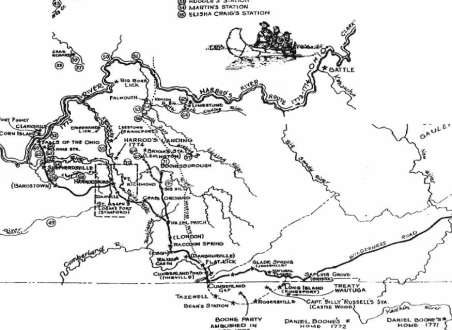
|
|
Map
showing locations of settlements in pre-1800 Kentucky (10a).
Herrodsburg,
shown in the square near the center of the map is said to be the
site where our Shortridge ancestors first arrived in Kentucky
(1779) after following part of Herrod's River Route (6).
Samuel Shortridge and his brothers settled at Boones Station
(home of Daniel Boone from 1779-1782) in the early 1780's, then
probably along creeks of the Kentucky river including near
Schollsville (laid out by the three Scholl brothers in 1792)
before moving to Indiana in the early 1800's. Boones Station, at
it's height, consisted of about 10-20 families in cabins enclosed
by an outside wall and ceased to exist by 1791. Today, where
Boones Station once existed is a 46 acre State of Kentucky
Historical Site.
|
The
Battle of Blue Licks.
During the Revolutionary War (1776-1782), the British were
encouraging Indian attacks on the colonial settlers.
The Battle of Blue Licks (1782) is considered the final battle
in the Revolutionary War and a notable event in Kentucky history.
Because of the intimate role of Samuel Shortridge with his relatives,
the Scholl brothers, and Daniel Boone in that battle, it might be
convenient to relate it here.
Briefly,
in August of 1782, British Captain William Caldwell led a force of
about five hundred Indians against the Kentucky settlement of Bryan's
Station. Many historians agree that Caldwell could have never
induced the Indians to so much mischief had it not been for a
provocateur named Simon Girty, an Enghlishman who had been living
with the Indians. However, the settlers at Bryan's Station were not
surprised by the attack and were able to shut themselves inside the
stockade for protection. The Indians tried for two days to gain an
upper hand to the settlers, but failed. After a loss of about
thirty killed and an unknown number wounded, the Indians retreated,
but only after burning crops and killing cattle. The next day,
three different relief parties of militia, each about fifty strong,
arrived at Bryan's Station from settlements at Boonsborough (led by
Daniel Boone), Lexington (led by Levi Todd), and Harrodsburg (led by
Stephen Trigg). As the senior militia officer present, John Todd
acted as commander-and-chief. The militia and settlers hastily
convened a council of war which resulted in a decision to pursue
immediately rather than wait for additional reinforcements. They
did, engaging Girty and his Indian raiders at Blue Licks in what
played out as an Indian ambush and defeat
of the Kentuckian militiamen. In the battle that resulted, 60 of 176
men who pursued the Indians were killed, including Boone's son,
Israel (then 33 years old).
Among
the militiamen that survived the Blue Licks Battle was Samuel
Shortridge, our ancestor, as well as his brother's-in-law, Peter
Scholl, Abraham Scholl, and Joseph Scholl (all of whom were in the
Boone group of militia).
Much
of what we know about Daniel Boone (which includes the Battle of Blue
Licks) was preserved by historian Lyman Draper who spent much of his
life interviewing individuals who had first-hand experience in the
events of the time. After his death, Draper's large collection of
information was published by the Wisconsin Historical Society and
found (on microfilm) in libraries with large collections.
In 1987-88,
I spent a lot of effort digging through the Draper manuscripts at
Purdue University (where I did postdoctoral studies in life science)
for information on our ancestors in Kentucky. It is from the Draper
Manuscripts and other information that I learned a lot of the details
about the Battle of Blue Licks. It's important to remember that
some of the eyewitness information on the Battle came from first or
second-hand interviews (including
children
of the participators who heard the events first hand) by Lyman
Draper.
Blue
Licks is a salt lick on the
Licking River system that at that time was described as mostly devoid
of vegetation for about a mile on each side, having been eaten by
buffalo who would come to lick the salt. After leaving Bryan's
Station, the militia rapidly arrived at a place where the Indians had
camped the night before. The next morning, the pursuers caught the
Indians at Blue Licks (36 miles from Bryan's Station) (11).
Since
the Indians were making no effort to conceal the trail, several in
the group, including Boone, advocated proceeding more cautiously, or
waiting to be reinforced by militia. Seeing some of the Indians in
the distance, Boone pointed out that after crossing the mile or so of
barren ground at Blue Licks that the woods and ravines there were a
likely point for an ambush. Historians have claimed that one
individual in the group, Hugh McGary (12), opposed Boone saying:
"We came to fight Indians, there they are." Boone
retorted, "If you are determined to go and meet the enemy at
this great disadvantage, go on, I can go as far in an Indian fight as
any other man." (13). According to one report, Hugh McGary
spurred his horse into the rivers and, swinging his rifle above his
head, exclaimed “Delay is dastardly! Let all who are not
cowards follow me!” Soon they all were across the river and
heading towards the woods.
As
Boone feared, the Indians had stopped and hidden in the woods,
planning to ambush their pursuers. The settlers approached the woods
in three groups of militia led by Colonels Boone, Todd, and Trigg
(14). The Indians killed all but three of an advance guard of 25
men with the first volley of shots. They then emerged from the woods
and set upon the settlers with tomahawks. The settlers, after firing
their rifles, had no time to reload and nowhere to hide, so soon it
was every man for himself. The battle had lasted less than a few
minutes and the rest was a panic-stricken retreat across barren
ground back to the river (which was about 3/4 of a mile away) with
the Indians in hot pursuit.
Some
managed to mount horses while others left all they had behind in
order to flee. Daniel led his men to the west into some woods for
escape. On the retreat, Daniel's son Israel stopped to fire as his
father ran by, and was shot in the breast. Our uncle, Abraham
Scholl, said that he ran by Israel, "hard
pressed" and saw
that he was "shot
with a very large ball".
Participators in the battle claim that the group under Daniel Boone
had fought much longer than the rest of the settlers.
Abraham Scholl told his nephew, Joseph Jr., (son of Joseph Scholl
and Lavina Boone) that
Israel could have escaped, but stayed to protect his father and was
killed (15).
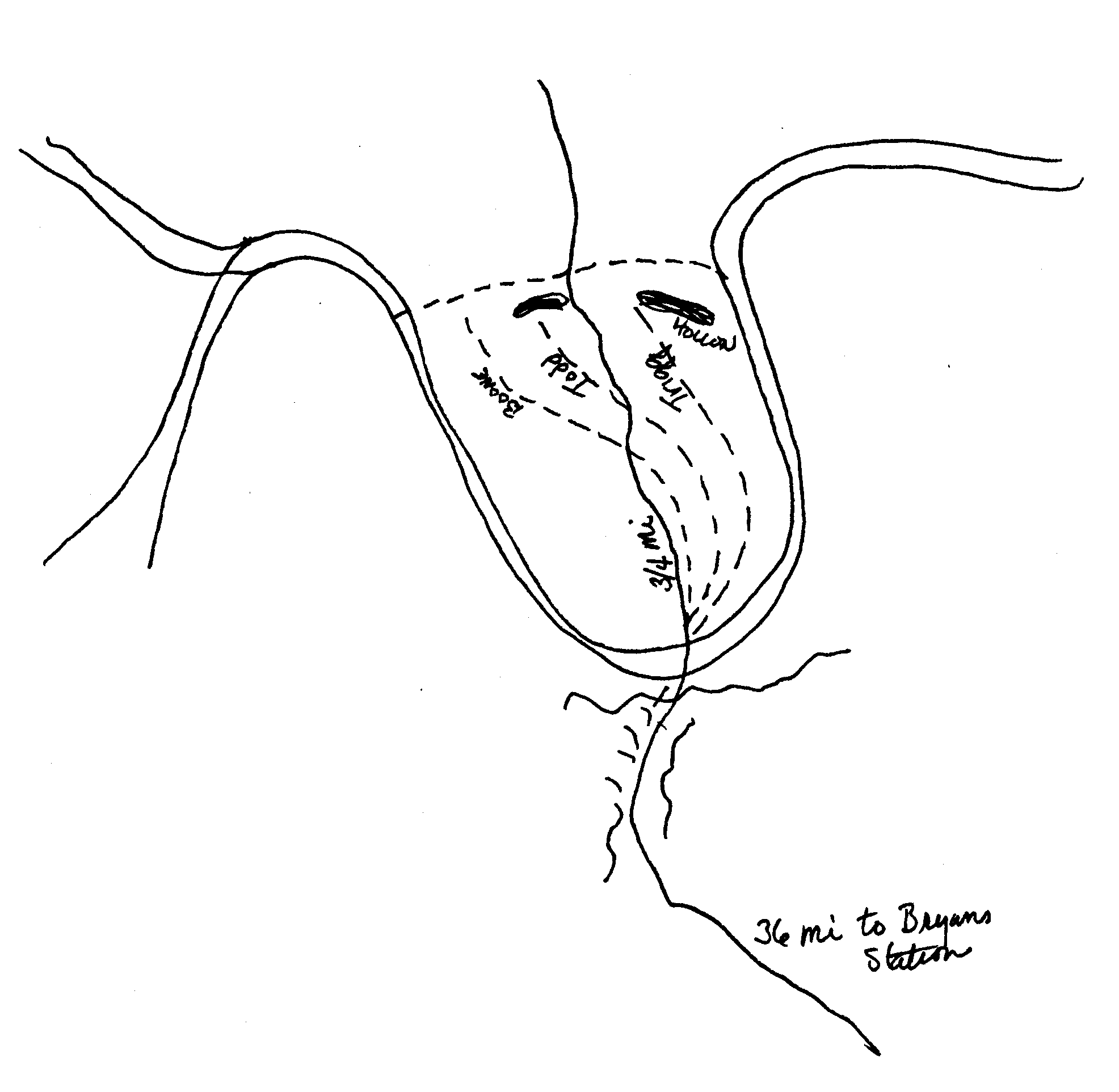
|
Map
of the Blue Licks Battlefield from an eyewitness account that is
recorded in the Draper MS, Vol 52J, page 37 (This drawing is my
copy of the hand-written map in the Draper MS). The battlefield
is at a bend in the Licking River.
This map shows the paths that militia under Col. Daniel Boone,
Col. Levi Todd, and Col. Stephen Trigg, took in approaching the
Indians, the initial battle taking place along the horizontal
dashed line at the top. The sink and the hollow (marked on the
map) is where the eyewitness said the Indians were hidden
to ambush the militiamen. Our ancestor, Samuel Shortridge, as
well as Peter Scholl, Joseph Scholl, and Abraham Scholl (all
brother-in-laws to Samuel Shortridge) fought under the group of
militia headed by Boone.
|
Peter
Scholl ran behind a small bark hickory and had the bark from it shot
into his face by an Indian bullet, cutting his face quite badly by
the splinters. Putting his hands to his face, he ran back
exclaiming, "I am a dead man." However, he was not
seriously hurt, and managed to survive (16).
Abraham
Scholl reached the river so weak that he turned to a companion,
Andrew Morgan, with the words: "I'm afraid I can't get over
the river with my rifle and I can't part with it." Morgan
told him: "Hold on to my shoulder as we pass the river,"
and thus, helped Abraham across. As they reached the other bank in
safety, Morgan, apparently feeling too thirsty to continue on told
Abraham: "Now you can wade out; I'll stop and
drink."--which, with rifle balls kicking the water up in
spurts around him, he did. Another man, after crossing the river,
and beyond the reach of bullets, sat down, untied his buckskin
leggings which were saturated with water in crossing the Licking, and
wrung them out, catching the water in his hat. He drank what he
wanted and then, after re-adjusting his leggings, escaped (15).
Here,
this narrative will continue with Daniel Boone's own account (16b):
“An
exceeding fierce battle immediately began, for about fifteen minutes,
when we being overpowered by numbers were obliged to retreat, with
the lost (sic)
sixty-seven men, seven of whom where taken prisoners. The brave and
much lamented Colonels Todd and Trigg, Major Harland, and my second
son, were among the dead. We were informed that the Indians,
numbering their dead, found they had four killed more than we; and
therefore four of the prisoners they had taken were, by general
consent, ordered to be killed in a most barbarous manner by the young
warriors, in order to train them up to cruelty; and they then
proceeded to their towns.
“On
our retreat we were meet by Colonel Logan, hastening to join us, with
a number of well-armed men. This powerful assistance we
unfortunately wanted in the battle; for, notwithstanding the enemy's
superiority of numbers, they acknowledged that, if they had received
one more fire from us, they should undoubtedly have given way. So
valiantly did our small party fight, that to the memory of those who
unfortunately fell in the battle, enough of honor cannot be paid.
Had Colonel Logan and his party been with us, it is highly probable
we should have given the savages a total defeat.
I
cannot reflect upon this dreadful scene, but sorrow fills my heart.
A zeal for the defense of their country led these heroes to the scene
of action, though with a few men to attack a powerful army of
experienced warriors. When we gave way, they pursued us with the
utmost eagerness, and in every quarter spread destruction. The river
was difficult to cross, and many were killed in the flight—some
just entering the river, some in the water, others after crossing, in
ascending the cliffs. Some escaped on horseback, a few on foot; and,
being dispersed everywhere in a few hours, brought the melancholy
news of this unfortunate battle to Lexington. Many widows were now
made. The reader may guess what sorrow filled the hearts of the
inhabitants, exceeding anything that I am able to describe. Being
reinforced, we returned to bury the dead and found their bodies
strewed everywhere, cut and mangled in a dreadful manner. This
mournful scene exhibited a horror almost unparalleled: some torn and
eaten by wild beasts; those in the river eaten by fishes; all in
such a putrefied condition, that no one could be distinguished from
another.”
Daniel
Boone managed to recognize Israel's body by its clothing and took him
back to Boone's Station. The rest of the bodies (not all were found)
were buried in a mass grave. One of the burial party told his
daughter that "they couldn't tell one man from another--of
the dead-the weather being so warm--they had swollen so much."
(11).
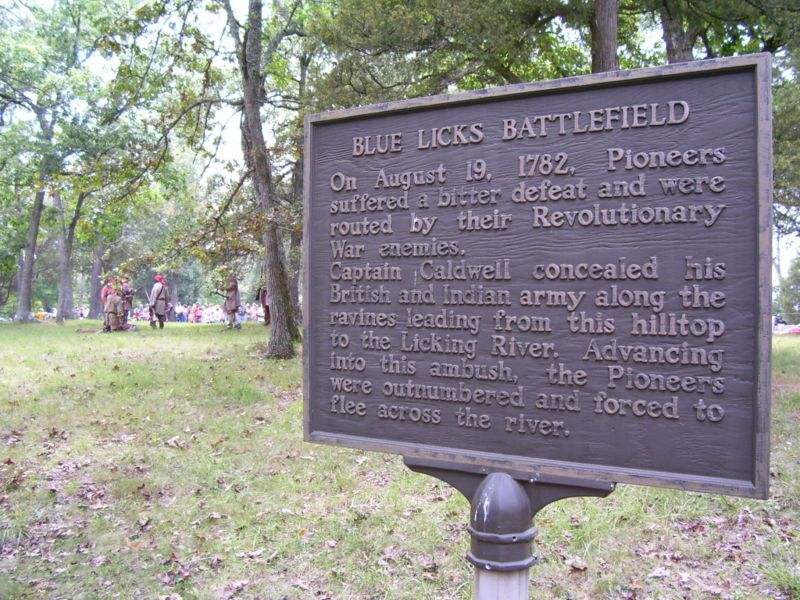
|
Monument
at Blue Licks Battlefield in Kentucky (photo from Wikipedia.com).
The Blue Licks Battlefield today is part of Kentucky's Park
system. Every year, reenactments take place near the time of the
anniversary of the battle (19 August, 1782).
|
Samuel
Shortridge and Joseph Scholl were listed by Daniel Boone in an
appraisal of horses, guns, blankets, and other equipment lost at Blue
Licks during this battle. Samuel Shortridge is listed as losing one
saddle (worth 15 shillings) and one blanket (worth 10 shillings).
Joseph Scholl is listed for the loss of one saddle (1 pound) and one
blanket (12 shillings)(17).
As
a result of the Battle at Blue Licks, a call was given for volunteers
and, in late October, a thousand mounted riflemen, under General
George Rogers Clark, came together at the mouth of the Licking river,
and marched through the Ohio forests to the Indian towns on the
Miami. Samuel Shortridge (Pvt), Abraham Scholl (Pvt), and Joseph
Scholl (Sgt) were in this group, all in Capt. Charles Hazelrigg's
company, under command of Colonel Daniel Boone (18). The Indians,
taken by surprise, fled the Indian towns without resisting. More
than five Indian towns were burned to the ground, including
Chillicothe. Samuel Shortridge would have been 26 years old at this
time. According to the muster roll of Hazelrigg's company (which is
in the Virginia State Library), Samuel Shortridge, Abraham Scholl and
Joseph Scholl enlisted 24 October 1782, and were discharged 25
November 1782. The muster roll is certified by signature of Daniel
Boone.
Each
in the Clark expedition was paid two pounds for his service. This
expedition put an end to large organized Indian raids into Kentucky
from Ohio. However, raiding parties continued to kill, scalp, and
molest
settlers in Kentucky until a treaty was signed in 1792 (11).
Post-Revolutionly
War Kentucky. Because of the low number of settlers
in Kentucky prior to 1779, and because of declarations by the King of
England, most of the land in Kentucky prior to 1781 was owned by
occupation of the property. After 1781, settlers started to declare
ownership of land and deeds started appearing in deed books (19). As
early as Dec 16, 1782 Samuel Shortridge obtained land (100 acres) on
a branch of the Kentucky River (20) (this was later withdrawn -
probably because of a land dispute, which was common in Kentucky at
that time). Samuel Shortridge obtained 100 acres on 12 Dec 1784,
another 100 acres on a branch of the Kentucky River on 25 Mar 1785
(20), and 150 acres (for 60 pounds current money of Kentucky) on 8
July 1794 (21). Franklin Boone Shortridge said that Samuel was a
blacksmith and a
farmer by trade. In 1782, he is listed in a voucher to the State of
Virginia as being due 14 shillings for 7 bushels of corn (17).
In
regard to our Shortridge and Scholl ancestors, there appears an
interesting tidbit of information from 1785. On November 13, 1785,
Boone's Creek Baptist Church was organized with the ministering help
of John Tanner and John Taylor with fourteen members entering into
the constitution. These fourteen were “Robert Fryer,
George Shortridge, Kizziah (sic) Shortridge, William Scholl, Leah
Scholl, Turner Crump, John Morgan, Samuel Boone, Sarah Boone, James
Hazelrigg, John Hazelrigg, Elizabeth Hazelrigg, Grace Jones, and
Margaret Shortridge” (22).
Our ancestors in this group were George Shortridge with his wife
Kezziah Shortridge (Keziah Read) (the parents of Samuel Shortridge)
and William Scholl with his wife Leah Scholl (parents of Sarah Scholl
who married Samuel Shortridge). I am not sure who is Margaret
Shortridge, but it is possible that she was the wife of John
Shortridge (son of George and Keziah) who later (early 1800's) moved
to Wayne Co, Indiana, just prior to Samuel Shortridge and their
families moving to the same place. At the very least, this record
is one of many that establishes the intimate relationship of the
Shortridge, Scholl, and Boone families.
In
a tax list of 1787, we find that Samuel Shortridge was listed as
taxed on the same day (07/05) as William, Joseph, Abraham, and Peter
Scholl (8). George Shortridge is listed on the same tax document,
but his name is entered on the date of 07/06 (one day after Samuel
Shortridge). George Shortridge, John Shortridge, Samuel Boone, and
Samuel Boone Jr. were listed on 07/07. Since the tax recorder had
to walk to each farm, this means that Samuel lived near his in-laws,
the Scholl's. About this time, Daniel Boone worked as surveyor with
Joseph Scholl as assistant, or "chopper". The chopper
would chop marks on trees to mark the boundaries of the plats (11).
In 1792 Daniel Boone and Joseph Scholl sold land they jointly owned
(11).
The
marriage of Samuel Shortridge to Sarah Scholl (born
1760)(married before 1782, Clark Co, KY) might have been his second,
the first being short-lived to Anne Roberts (January 25, 1778 in
Montgomery Co., KY). As far as we know, all of Samuel's children
were by his second wife, Sarah. These children were:
(i)
Keziah Shortridge; born 1782, probably in Kentucky; married Samuel M.
Black 18 May 1801 in Bourbon Co, KY. Keziah, and her husband,
Samuel Black, are recorded as being the first "white settlers"
to settle in what is currently Tippecanoe Co., moving to what is now
Wea Township in 1822, or potentially a year earlier (23). Based on
the marriage date, Keziah Shortridge and Samuel Black must have come
from Kentucky. Samuel Black and Levi Thorton were first two to
build log cabins in Wea Twp, doing so in 1822. In that part of the
county, the there is a very rich prairie land called the "Wea
Plain". The first settlers to move to Tippecanoe Co. set up
their homes on this land - the Wea plain - because it made good
farmland. In 1824, Samuel Black purchased two plats of 80 acres each
from the Federal Government, and in 1825, and 1827, purchased two
more plats of 80 acres each, all within Wea Twp (24). In 1825,
Samuel and Keziah started the first school, which was taught in their
log cabin, and called the "Black Schoolhouse" (23). Samuel
Shortridge (and probably Sarah Scholl) was buried on part of the land
that Samuel Black owned, once referred to as the "Black
Cemetery" and now called the "Rural Cemetery". In the
same cemetery is a stone that reads: Joseph M., Son of Samuel and
Keziah Black, who departed this life Sept 20, 1838, aged 9 years, 7
months, and 9 days (25). One of Morgan Shortridge's ancestors,
Gerald Ray (in the 1980's), told me that he remembers seeing Samuel
Black's grave there when he was a young man (26, 26a).
(ii)
Leah Shortridge; born 1783, probably in Kentucky; married William
Stark(es) 11 Mar 1802 in Bourbon County, Kentucky (27).
(iii)
James (“Jesse”?) Shortridge; James is mentioned in Samuel
Shortridge's Will (29). I believe that this individual was also
known as Jesse Shortridge who was born Oct 24, 1792 in Bourbon
County, KY, married Catherine Crum on Sep 13, 1815 in Wayne County,
Indiana, died on October 10, 1853, and is buried in what became the
Stockbridge Cemetery in Carroll County, Indiana (27a). Jesse
Shortridge appears to be closely affiliated with Selah Shortridge
(Drury) and John Franklin Shortridge who would both be siblings of
Jesse if I am correct on this identification. At the present time, I
know of no other parental identification for Jesse Shortridge and,
given the circumstances and relationships, this one makes the most
sense (that James went by the name Jesse).
(iv)
Elizabeth Shortridge; born about 1787; married Griffin Treadwell
(or Tredwell) (28). A daughter named Linda is mentioned in Samuel
Shortridge's Will (29).
(v)
Sarah Celia (“Selah”; “Sally”) Shortridge; born 10 Mar 1787
in Bourbon Co. Kentucky; died 6 Feb 1863; married to Arnold Drury (
b 24 Jan 1792, d 24 Dec 1858) on 7 Jun 1816 in Wayne Co., Indiana.
Arnold was a soldier in the War of 1812 and was present at the murder
of John Shortridge (Jr.) who had the misfortune of wearing (Isaiah)
Drury's coat (related elsewhere). After Arnold and Selah were
married, they moved to Henry County, Indiana, and about 1828 to
Madison County, Indiana. The oldest son of Selah Shortridge and
Arnold Drury, Squire Thomson Drury (with wife Rebecca C. Newton)
started on the Oregon Trail with their relatives, Samuel Boone
Shortridge, Emily Heath, and William Wallace Shortridge. At that
time, Squire Drury and his wife (Rebecca C. Newton) had five young
children who accompanied them on their trail to Oregon: (i) Melissa
Ellen (about 9 years old), (ii) Emily Francis (about 7 years old),
(iii) Celinda Susan (about 5 years old), (iv) Newton (about 3 years
old) and (v) Wells (about 1 year old). Near the end of July of
1852, cholera struck the immigrants, resulting in the deaths of both
parents (Arnold Drury, died 31 July 1852; Rebecca Newton, died 3
Aug 1852) leaving their five young children as orphans. A Drury
family history (see Appendix) states that the Drury orphans were
cared for by Samuel Shortridge and William Wallace Shortridge (then
about 16 years old) who brought them through to Oregon (28). For
notes on the children of Selah (“Sally”) Shortridge and Arnold
Drury, see references and notes (30).
(vi)
Samuel Boone Shortridge (our Oregon ancestor)(middle
name is sometimes spelled without the 'e' as 'Boon'). Samuel
Boone Shortridge was born 15 Sep 1796 in Bourbon Co, Kentucky, and
died on 21 Jul 1877. He moved with his parents, in 1814, to Wayne
Co., Indiana, and again in 1822-1823 to Montgomery (now Tippecanoe
County), Indiana. There he married Emily A. Heath on 2 June 1825
(31). While they lived in Indiana, they had at least two children
born to them: Caroline Shortridge, born on 24 May 1828, and James H.
Shortridge, born on 18 July, 1831. The 1830 census shows that Samuel
had one girl and one boy under five years of age. This indicates
that they may also have had children who died in infancy. In a
portrait of James H. Shortridge, it is mentioned that there were
seven children born to Samuel Shortridge and Emily A. Heath (32).
Samuel and his family later (bef 1836) moved to Muscatine County,
Iowa, where they lived for several years. Samuel Shortridge, with
his son William Wallace Shortridge, immigrated to Oregon via the
Oregon Trail in 1852 and occupied a Donation Land Claim of 160 acres
near Cottage Grove Oregon (part of which is now Shortridge Park).
Emily Heath did not arrive in Oregon because she died in Iowa before
starting out on the Oregon Trail or she died while on the Trail. In
1958, Samuel disposed of his land claim and left from Sacramento, CA,
with a few others in a Mormon company going to Ogden, Utah (related
elsewhere), where he spent a short time, afterwards returning to
Oregon where he took up residence with his son, James H. Shortridge.
Samuel is buried in Taylor Lane Cemetery near Cottage Grove, Oregon.
Based on markings on his headstone and other information, he belonged
to the Masonic brotherhood.
(vii)
Morgan Shortridge; born 15 Oct 1798 in Bourbon County, Kentucky;
died on 22 Dec 1858. He moved with his parents to Wayne County,
Indiana, in 1814, and again to what is now Tippecanoe Co., Indiana,
in 1822-23. On 24 Jun 1828, he married Clarissa Burk, daughter of
William Burke, in Tippecanoe Co, Indiana. Morgan permanently made
Tippecanoe County his home instead of moving west when his brother,
Samuel Boone Shortridge, left Tippecanoe County and moved to Iowa.
Morgan was actively involved in politics and became the first sheriff
of Tippecanoe County. He later served in the Indiana State
Legislature. Morgan Shortridge, his wife Clarissa, and some of their
children and grandchildren are buried in Wildcat Cemetery, Tippecanoe
County, Indiana. Morgan and Clarissa had two sons and five daughters
who were well documented in the Tippecanoe Historical Society files
by Alameda McCollough (deceased), president of the society, who was a
descendant of Morgan Shortridge (33). Morgan Shortridge's will was
probated on 5 Jan 1859 (34). According to descendants of Morgan
Shortridge, his given name is likely derived from his grandmother's
unmarried surname, Morgan. Leah Morgan (or Jane Morgan, as listed in
family histories by Morgan's descendants) is said to be the second
wife of William Scholl (35).
(viii)
John Franklin Shortridge; born 1801 in Bourbon Co., Kentucky; died
1847 and buried in the New Lisbon Cemetery, Indiana; married Emma
Anna Crum on May 10, 1821 in Wayne County, Indiana. Emma Anna Crum
is a sister of Catherine Crum who had earlier married Jesse (re:
James) Shortridge in Wayne County, Indiana. On 23 Dec 1824, John
Shortridge purchased two plots of land of 80 acres each near what
became the Shortridge farm, in Tippecanoe Co., Indiana (24), but he
appears to have moved to Henry County, Indiana, before 1830. A son
of John Franklin Shortridge was Abram Crum Shortridge whom became
President of Purdue University in 1874, second president of the
university. Shortridge High School in Indianapolis, Indiana, was
also named after Abram Shortridge (36, 37). A grandson of John
Franklin Shortridge was Samuel Morgan Shortridge who became a
prominent attorney in California and served as United States Senator
from that State (28).
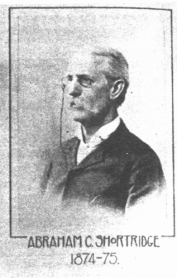
|
Abram
Crum Shortridge, the son of John Franklin Shortridge and nephew of
Samuel Boone Shortridge, was the second president of Purdue
University, serving two years (1874 - 1875). Shortridge High
School in Indianapolis Indiana was also named after him. This
photograph was published in The Purdue Exponent, front
page, May 6, 1987.
|
VI.
From Kentucky to Indiana
(Samuel
Shortridge > Samuel Boone Shortridge)
By
the turn of the century, the old settlers in Kentucky were getting
tired of all the disputes over land and the large number
of people moving into the region. The situation with property
disputes made Daniel Boone so angry that he moved from the state in
1798 to what is now Missouri and vowed never to return to the state
again (1).
On
11 Mar 1811, Samuel Shortridge and his wife, Sarah (Scholl), sold
property to a John Hodges (2). In 1814, Samuel Shortridge
(b 1756) and his family moved to Wayne Co, Indiana, following his
younger brother, John (b 1765), who migrated to Wayne Co, Indiana in
1811, securing 640 acres of land (recorded 23 Oct 1811) that he
(John) divided into four 160 acre portions, keeping one for himself
and reportedly giving two others to his brothers and a brother-in-law
(3).
In
the 1810 census of Kentucky, we find Samuel, George, and John
Shortridge living in Bourbon Co, Kentucky. By the time of the 1820
census, none of them are in Bourbon, KY and we find Samuel, Samuel
Jr., John, and George as heads-of-household in Wayne Co, Indiana.
Based on census records, I believe that these were Samuel and John
Shortridge, brothers, and John's two sons, Samuel (marr Eleanor
Hulse) and George (3). Jesse Shortridge is listed as marrying
Catherine Crum on 13 September 1815 in Wayne Co, Indiana, but his
name does not show up on the census (possibly because he is living
under a different head-of-household or because he has moved on)(4).
Jesse Shortridge seems to appear out of nowhere and has not yet been
connected to parents by other genealogical researchers, but I believe
that he was, in reality, James Shortridge, son of Samuel Shortridge
and Sarah Scholl and brother of Samuel Boone Shortridge. Jesse
Shortridge later appears in Henry County, Indiana, with Selah
Shortridge (Drury)(who would be his sister and brother-in-law) and
with John Franklin Shortridge and Anna Crum (his brother and
sister-in-law). If my identification of 'Jesse' as James Shortridge
is correct, then this would mean that two brothers (Jesse and John
Shortridge) married two sisters (Catherine and Anna Crum) from
another family, something that appears several times in Shortridge
history.
The
History of Wayne Co has it that one of the earliest settlers in the
region was John Shortridge who “in 1809 or shortly thereafter”
and “settled near and south of East Germantown”.
John's son, George Shortridge, is said to have laid out the town of
Germantown “mostly on his own land”, calling it
Georgetown, but the name was later changed to Germantown in 1832 when
the town wished to have a post office established (5). Here was
built a stockade (referred to as Shortridge Fort) which John
Shortridge built in 1811. According to descriptions, the front of
the stockade entered Plum creek so as to furnish water if the fort
was besieged.
In
a historians article in the Richmond Paper (6), information about the
Shortridge-built fort and related events are described in such a way
that it may be best here to transcribe portions verbatim:
“In
1811, John Shortridge, better known on the frontier as “Jacky”
Shortridge, erected a log block house on his land just north of where
the Pennsylvania bridge crosses Plum Creek, a small stream that comes
along Germantown on the east and south.
“During
the uprising of the Indians in 1812, this was enclosed by a stockade
of split logs placed upright in the ground.”
.
. .
“The
town of East Germantown was laid out by George Shortridge in 1827.
“The
surveyor was John Beard, a native of North Carolina, who settled
where Elkhorn church now stands in 1808 (7).
“He
was the first treasurer of Wayne County.
“George
Shortridge was a native of Kentucky and a graduate of Georgetown
college.
“His
uncle, John Shortridge (8),
came to Indiana, one informant says, as early as 1808, but the
records show that in 1811 he received a certificate of purchase from
the government for 640 acres of land where Germantown now is.
“This
land was divided into four quarters of 160 acres each.
“One
tract he kept, two were given to two brothers, and one to a
brother-in-law
(9).
“It
is therefore probable that the came early and sought out the best
land for a family location.
“The
new town was named Georgetown, but later in 1832, when it sought to
have a post office established, the name was found in conflict with a
post office (___line missing____) and changed to Germantown.
“This
name was erroneously attributed to the influx of Pennsylvania Germans
at this period. t was named for Germantown, O., from which vicinity
came nearby settlers and a few business interests about that time.
“Afterward
the word East was prefixed to distinguish from Germantown in Marion
County.”
Another
article in the Indiana newspaper series continues with other
information of interest regarding the burial place of John Shortridge
and the murder of his son of the same name (again, this would have
been the brother and the nephew of our ancestor, Samuel Shortridge):
“The
east and west of the stockade were south to a point where a small
plat of uncultivated ground existed in Bond's field and known as a
burial place.
“It
is here that rest the bones of John Shortridge who died in 1823, and
also those of his son, John, who was killed by the Indians in 1813.
“Young
Shortridge was returning home from Symonds mill near where Milton now
stands, and was riding a white horse.
“He
was accompanied by Arnold Drury, a son of Isaiah Drury and as the day
was stormy he was wearing a coat belonging to Drury.
“John
Green was an Indian of ill repute in the settlement and after whom
was named the beautiful stream, Greensfork of Whitewater.
“Green,
the Indian, had sworn to kill Drury at sight and it was probably that
he mistook Shortridge for Drury and shot him. Drury was walking some
distance in the rear and heard the shot.
“
The horse ran home on the trail to Shortridge's fort. Young Drury
found his companion mortally wounded and with the aid of the garrison
had him conveyed to the fort.
“He
died the next day and evening following was buried in the extreme
south point of the stockade.
“Elisha
Willett's first wife died in childbirth, brought on by the excitement
incident to the expected Indian attack and requested to be buried by
the side of Shortridge.
“The
coffins were made from the puncheon floor of the block house and
fastened together by horseshoe nails.
“They
were buried in one grave. Our informant of these facts was the late
Issac M. Bear, and was five years old at the time of this fearful
incident in frontier life.
“He
says that the burial took place when the shades of night were falling
fast and was an occasion of much sorrow.
“Strong
men wept and pledged themselves to avenge the death of young
Shortridge, but Green hurriedly left the county and was never
apprehended. He died in Iowa many years ago.
“The
fort long since crumbled to dust. Not even a stone marks the grave
of father and son who played such a conspicuous part in the early
settlement of the eastern portion of what is now Jackson township,
but then the county of Dearborn.”
As
a note of interest, three years after the incident described above,
Arnold Drury married Selah (Sally) Shortridge (1816), daughter of
Samuel Shortridge and Sarah Scholl. It was the Drury's oldest son,
Squire Thompson Drury, and wife, Rebecca Newton, and their children
who later migrated to Iowa and started across the Oregon Trail in the
same wagon train as Samuel Boone Shortridge and Emily Heath.
A Drury family history stated that Squire Thompson Drury, his wife,
Rebecca Newton, died on the Trail after they contract cholera
(10), a disease that was a chief cause
of deaths on the Oregon Trail.
In
late 1822 or early 1823 Samuel Shortridge Sr. moved with his family
from Wayne Co, Indiana, to what is now Tippecanoe Co., Indiana.
Moving at the same time was at least two of Samuel and Sarah's sons
(Samuel Boone and Morgan, and probably John). Samuel's daughter,
Keziah, with her husband Samuel Black, had arrived in the area a year
earlier, being called the first "whites" to settle in Wea
Township of Tippecanoe Co., Indiana (11). Shortly after arriving
there, Samuel Shortridge died, on July 8, 1823, at 67 years of age
(12). He was buried on land owned by his son-in-law and daughter,
Samuel and Keziah Black (see maps below)(13). Sarah also died in
Tippecanoe County and is probably buried near Samuel in the Rural
Cemetery (13, 14).
During
this time, Samuel Boone and Morgan were young bachelors. Their
older brother, John (James), and their younger brother, John, had
married sisters in 1815 and 1821 in Wayne County. However, the
bachelor brothers, Samuel and Morgan, both married after arriving in
Tippecanoe County, Samuel Boone Shortridge to Emily Ann Heath in 1825
and Morgan Shortridge to Clarissa Burk three years afterwards (in
1828). In 1824, their younger brother, John Shortridge, purchased
two plots of land of 80 acres each (15) and probably lived for a
short time in Tippecanoe County before settling permanently in Henry
County (Indiana) prior to 1830 (16). Unlike his other brothers,
Morgan Shortridge made Tippecanoe County his permanent home. He and
several members of his family are buried in Wildcat Cemetery near to
the land that his family occupied (see maps and photos below).
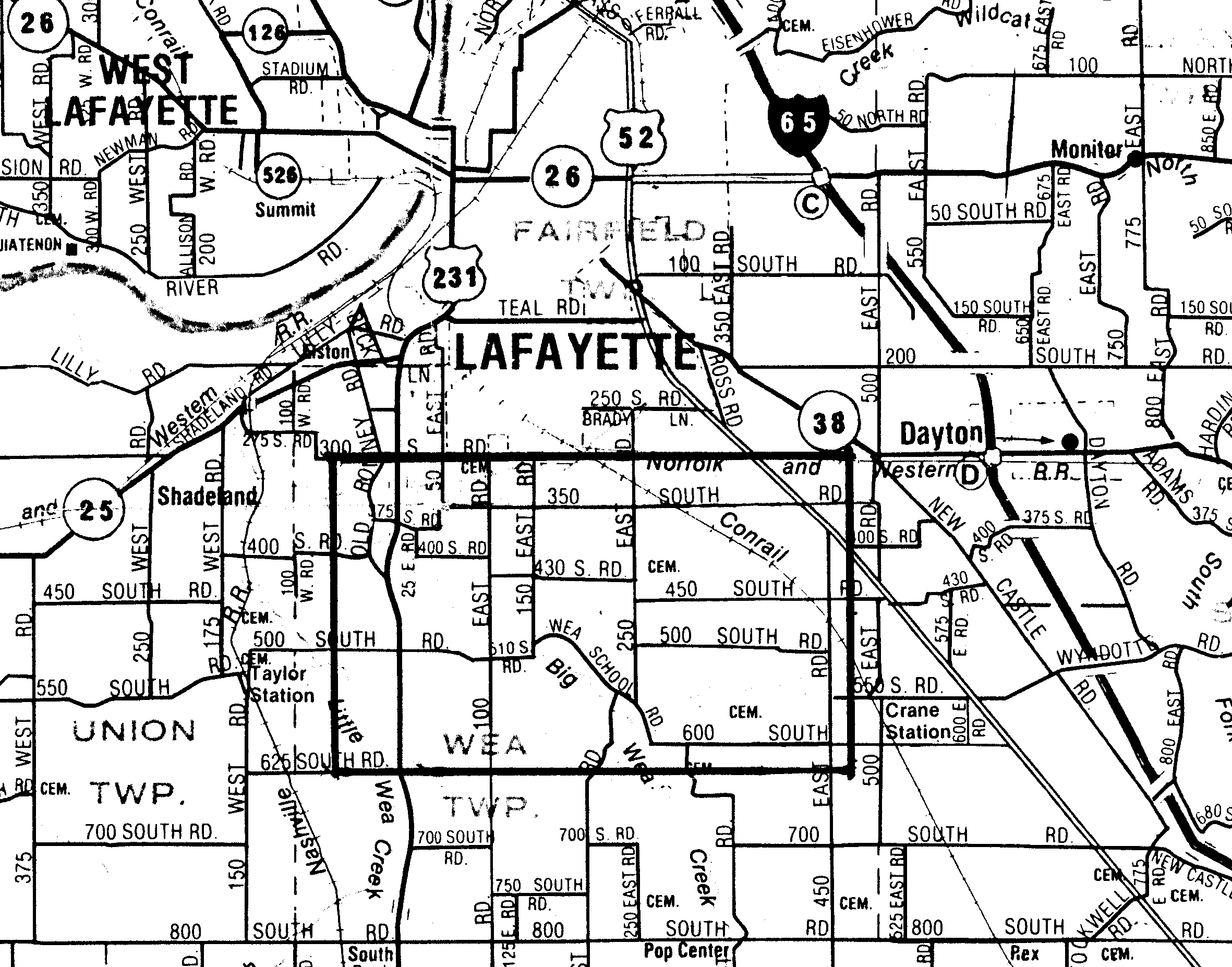
|
|
Modern
map of portions of Tippecanoe County, IN, near the city of
Lafayette. The boxed area designates the approximate area shown in
the circa 1880's map below.
|
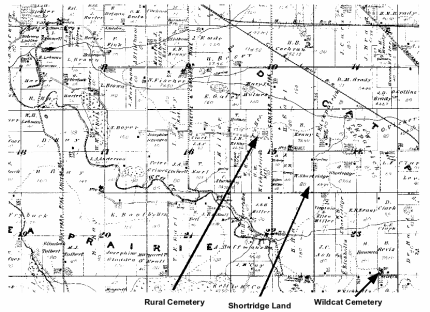
|
|
Map
(circa 1880) showing ownership of plats of land. The plats
belonging to W. Shortridge and S. Shortridge were divided from a
large plat in Morgan Shortridge's will. Morgan Shortridge (who
is buried in Wildcat Cemetery) was a son of Samuel Shortridge
(who is buried in Rural Cemetery) as well as a younger brother of
Samuel Boone Shortridge (our ancestor) who left this area for
Iowa, afterwards migrating to Oregon. Rural Cemetery is located
on land once owned by Samuel Black and his wife, Keziah
Shortridge. By 1988, the cemetery had gone to ruin, but it was
restored and rebuilt in 2002 which included a ceremony by the SAR
in honor of the Revolutionary War service of Samuel Shortridge
(18-20).
|
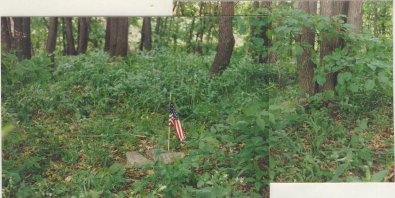
Photographs
of resting place of Samuel Shortridge in Rural Cemetery,
Tippecanoe Co, IN, as we located it in 1988. The headstone reads
“In memory of Samuel Shortridge who departed this life July
8, 1823 aged 65 years”. At that time (1987) the Rual
cemetery was unmarked and neglected. The broken headstone was
repaired in 2002 when the Sons of the American Revolution (SAR),
Daughters of the American Revolution (DAR), and other groups
restored the cemetery and erected a monument to Samuel's service
in the Revolutionary War. Samuel Shortridge's wife, Sarah
Scholl, is believed to be buried at this same site (13, 14).
|
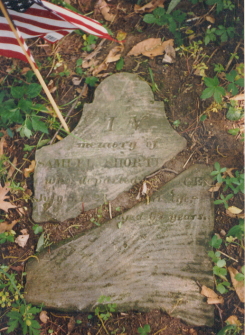
|
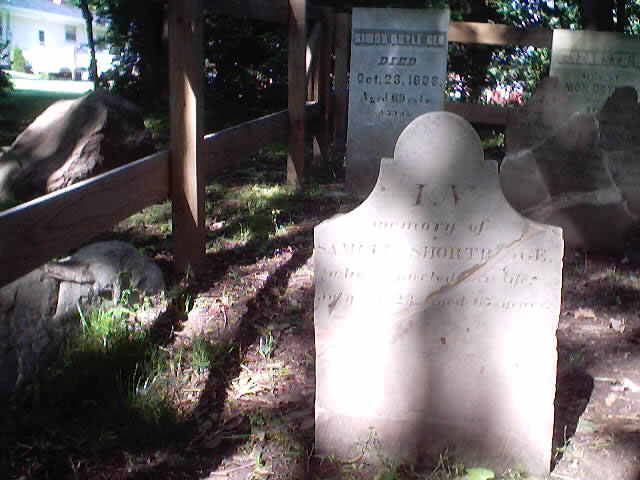
|
Repaired
gravestone of Samuel Shortridge in Rural Cemetery in Tippecanoe
County, Indiana. The cemetery was cleaned up and reclaimed in
the years immediately prior to 2002, the broken stone repaired,
and the SAR and DAR groups held a memorial service in 2002 for the
Revolutionary War service of Samuel Shortridge (18-21).
|
The
Indiana SAR and DAR groups provided a new memorial stone for
Samuel Shortridge which was dedicated in a service held on May 18,
2002. Photo from a SAR website (18-21).
|
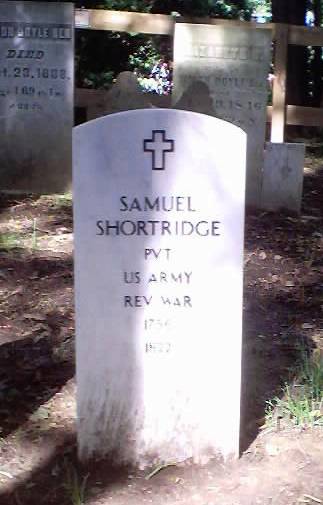
|
Samuel
Shortridge purchased 80 acres of land on the Wea Plain in Tippecanoe
County, Indiana on 1 Oct 1829
(15).
At this time, Samuel’s brother, Morgan, was
serving as sheriff of Tippecanoe County (the first sheriff after the
county was organized)(17).
Samuel worked as a farmer and blacksmith.
As
related elsewhere, Samuel Shortridge and Sarah Scholl had eight known
children. Six of their children (Keziah, James, Selah, Samuel,
Morgan, and John) appeared to have emigrated from Kentucky to
Indiana, either at the same time as their parents or within a few
years of each other. It appears that some of his children,
including James, Selah, Samuel, Morgan, John spent time living in
Wayne County, Indiana, before moving to other parts of Indiana. At
the time that Samuel Shortridge and Sarah Scholl moved from Kentucky
to Indiana, daughters Keziah and Leah are the only two children known
to be married. Keziah, Samuel, Morgan, and John obtain land in
Tippecanoe, Indiana, indicating that they accompanied their parents
to this region of the country in the 1820's. Keziah (married Samuel
Black) and Morgan Shortridge settled in Tippecanoe County permanently
while the other two brothers moved, John to Henry County Indiana
where he lived to the end of his life, and Samuel (our Oregon
ancestor) moved to Iowa (covered in the next chapter) before
traveling upon the Oregon Trail to the Willamette Valley in Oregon in
1852.
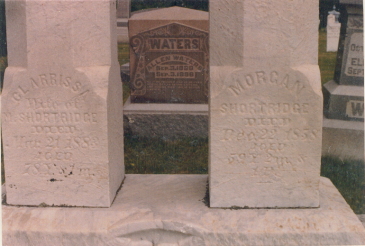
|
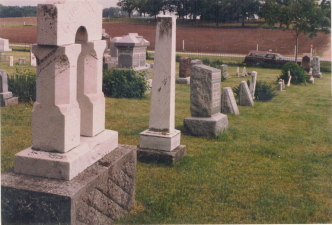
|
|
Shortridge
Row in the Wildcat Cemetery in Tippecanoe, Indiana. These are
burial places for Morgan Shortridge's family. Morgan was a
younger brother (by 2 years) of Samuel Boone Shortridge. In the
lower photograph (from L to R) are the grave sites for Clarissa
(Burk) Shortridge, Morgan Shortridge, Clarissa (Shortridge)
McCollough, William B. Shortridge, Leah (Vanscoy) Shortridge,
Edgar S. Shortridge, Jessie F. Shortridge, Samuel Morgan
Shortridge, Samuel Shortridge, and Willie W. Shortridge. The
upper photograph shows the gravestones of Morgan Shortridge and
his wife, Clarissa Burk(e). See Chapter V, note 33 for children
of Morgan and Clarissa (Burk) Shortridge.
|
While
living in Tippecanoe County, Samuel Boone Shortridge and Emily Heath
had two children, Caroline Drennon Shortridge, born
in 1828, and James Henderson Shortridge, born in 1831. By
the time of the 1830 census, John Shortridge, Jesse (James)
Shortridge, and Selah (Shortridge) Drury are found living in Henry
County, Indiana. At some time prior to 1836, Samuel Boone
Shortridge and his family moved to Muscatine Iowa where William
Wallace Shortridge was born.
Children
of Samuel Boone Shortridge and Emily Ann Heath (all of whom went to
Oregon via the Oregon Trail) were:
(i)
Caroline Drennon Shortridge,
born May 24, 1828 at Lafayette (Tippecanoe County), IN; died in June
1919 at Eugene, Oregon; married James Whitely Emmons on Jan 4, 1852;
J.W. Emmons died on Feb 14, 1870; second marriage to Hiram Stewart
on May 30, 1873; Hiram Stewart died on Jul 25, 1892; Caroline and
her family came to Oregon on the Oregon Trail in 1866.
(ii)
James Henderson Shortridge,
born July 18, 1831 in Tippecanoe County, Indiana; died on 25 Oct
1916. James came to Oregon in 1851 in 'Millers Train', said to have
covered the trip in one of the fastest times known. James Henderson
Shortridge married Amelia Savannah
Adams on April 7, 1853. Amelia
was born on Feb 12, 1833 and came to Oregon from Iowa in 1852 in the
same wagon train as Samuel Boone Shortridge and William Wallace
Shortridge, of which her father, John Franklin
Adams, was the wagon-master. Amelia Adams is said to be the first
white woman to set foot in sight of what is now the Dam near
Shortridge Park, south of Cottage Grove, Oregon (22).
Amelia
Adams died
on Jul 31, 1919. James Henderson
Shortridge and Amelia Susanna Adams had seven known children.
(iii)
William Wallace Shortridge,
born 30 March 1836 in Muscatine County, Iowa. In 1852, at sixteen
years of age, he went across the Oregon Trail with his father, Samuel
Boone Shortridge. His mother, Emily Ann Heath, appears to have died
in Iowa. He enlisted in the Rouge River Indian Wars on 13 February
1856 in Company A under the command of Captain Ladshaw. He
participated in the battles of Cow Creek, Big Meadows, and many other
minor engagements. He was discharged after a service of four months
and nineteen days. He married Ellen Jane Keyes 4 August 1861. Ellen
Jane Keyes was born 12 March 1846 in Nauvoo, Hancock County,
Illinois, a daughter of a devout Mormon family. They located six
miles south of Cottage Grove, Oregon, for three years, then
afterwards moved to Pass Creek near Divide, Oregon, for two years.
William Wallace Shortridge and Ellen Jane Keyes then bought one
hundred sixty acres of land eleven miles south of Cottage Grove. In
1883, he built a sawmill on this land. William Wallace died at his
home in Cottage Grove on 29 April 1922. Ellen Jane Keyes was killed
in a train-auto accident on 9 April 1926. William Wallace Shortridge
and Ellen Jane Keyes had eleven children.
Return to main page

